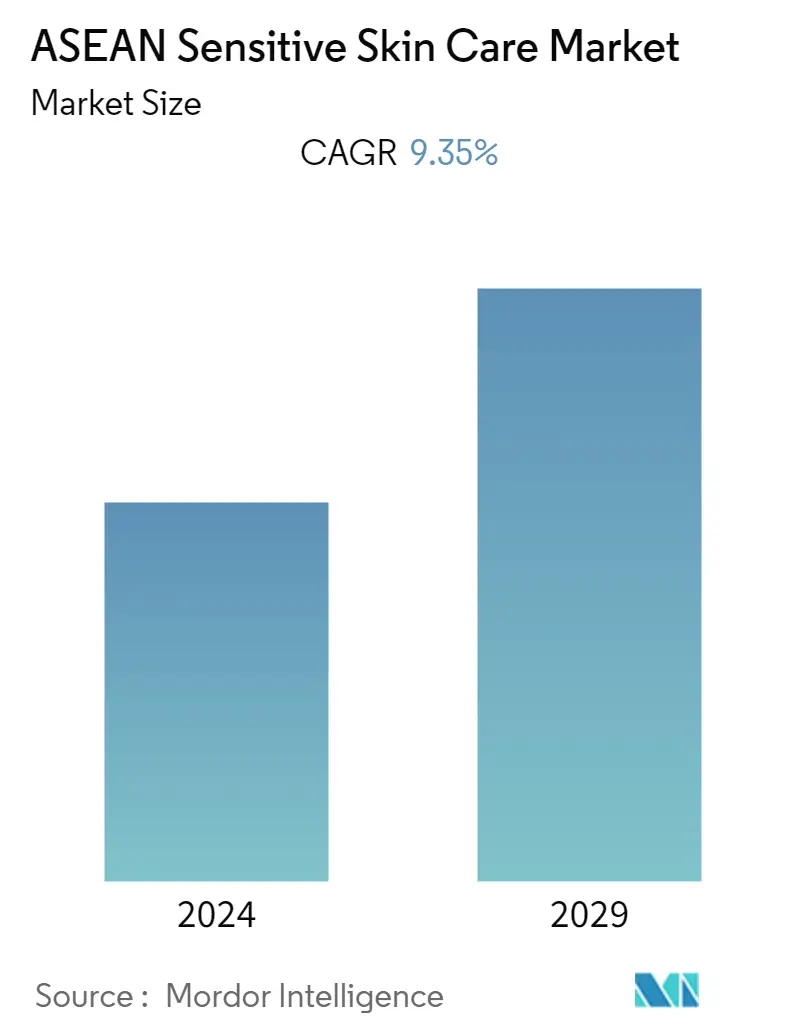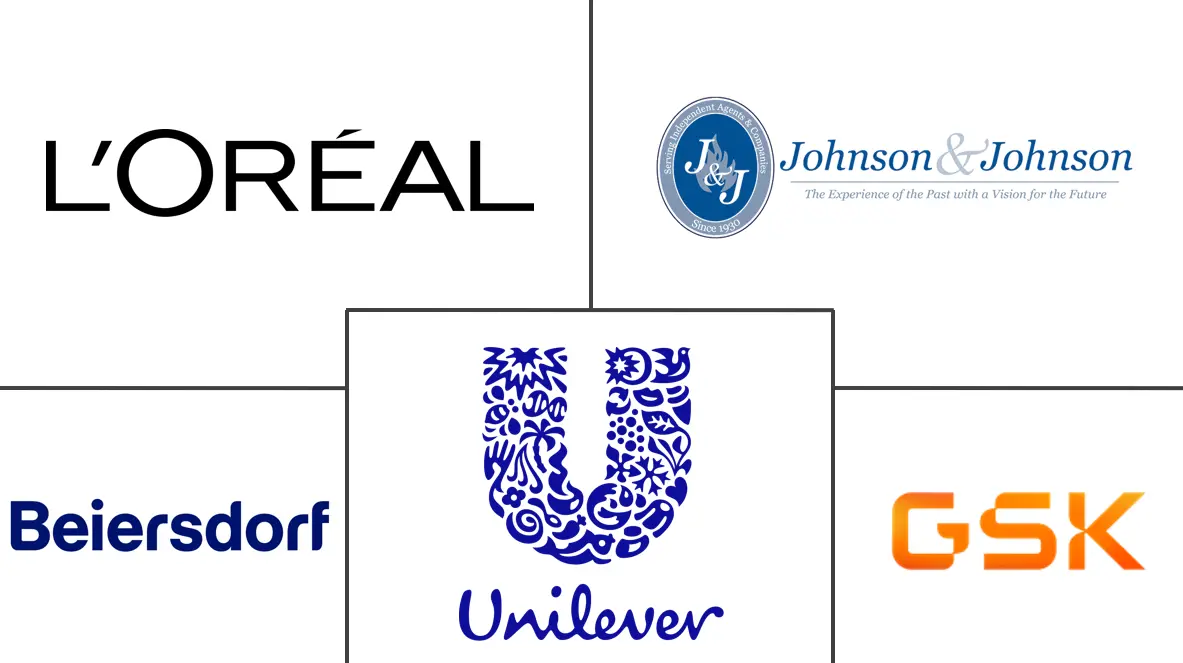Market Size of ASEAN Sensitive Skin Care Industry

| Study Period | 2019 - 2029 |
| Base Year For Estimation | 2023 |
| Forecast Data Period | 2024 - 2029 |
| Historical Data Period | 2019 - 2022 |
| CAGR | 9.35 % |
| Market Concentration | Low |
Major Players
*Disclaimer: Major Players sorted in no particular order |
Need a report that reflects how COVID-19 has impacted this market and its growth?
ASEAN Sensitive Skin Care Market Analysis
The ASEAN sensitive skin care market size is expected to grow from USD 1.45 billion in 2023 to USD 2.27 billion by 2028, at a CAGR of 9.35% during the forecast period (2023-2028).
- The ASEAN region comprises tropical countries like Thailand, Indonesia, Malaysia, and Singapore. The skin of people residing in these countries is more prone to irritation and sensitivity due to enhanced exposure to sunlight and high humidity weather effects. Not only does the climate impact the microbiome balance of the skin, but it also leads to numerous skin conditions like atopic dermatitis, eczema, redness, dark skin, acne, pigmentation, and dullness.
- Therefore, with rising disposable incomes and increasing focus on grooming habits and self-perceptions among emerging adults, there has been a significant rise in the demand for skin care products in the region. According to a survey by UN Comtrade, the value of cosmetics and toiletries imports from Japan to Singapore amounted to around USD 750.75 million in 2022.
- Moreover, companies are launching products targeting individuals with sensitive skin. For instance, in 2022, in collaboration with LABORÉ and other skin experts, Paragon launched a range of LABORÉ products designed especially for sensitive skin in low-climate countries. The product range comprises barrier revive cream, mild cleanser, hydration toner, physical sunscreen, and skin nutrition gel labeled as alcohol and fragrance-free, non-comedogenic, dermatologically tested, vegan, and cruelty-free. Such innovations, along with emerging minimalist and clean beauty trends, will likely create a positive outlook for the market during the study period.
ASEAN Sensitive Skin Care Industry Segmentation
Sensitive skin care products are specifically designed for those with sensitive skin and skin conditions. These products contain mild ingredients that do not aggravate existing skin issues and are gentle on the skin.
The ASEAN-sensitive skincare products market is segmented by product type, distribution channel, and country. Based on product type, the market is segmented into cleansers, creams & moisturizers, serums & essence, toners, and other classes. Based on distribution channels, the market is segmented into supermarkets/hypermarkets, specialty stores, pharmacies, drug stores, online retail stores, and other distribution channels. Based on country, the market is segmented into Indonesia, Thailand, Singapore, Malaysia, Philippines, and the Rest of ASEAN.
The market sizing has been done in value terms in USD for all the abovementioned segments.
| Type | |
| Cleansers | |
| Creams and Moisturizers | |
| Serums and Essence | |
| Toners | |
| Other Types |
| Distribution Channel | |
| Supermarkets/Hypermarkets | |
| Specialty Stores | |
| Pharmacies and Drug Stores | |
| Online Retail Stores | |
| Other Distribution Channels |
| Geography | |
| Indonesia | |
| Thailand | |
| Singapore | |
| Malaysia | |
| Philippines | |
| Rest of ASEAN |
ASEAN Sensitive Skin Care Market Size Summary
The ASEAN sensitive skin care market is experiencing significant growth, driven by the unique climatic conditions of the region, which include high humidity and intense sunlight exposure. These factors contribute to a higher prevalence of skin sensitivity issues such as eczema, acne, and pigmentation. As a result, there is a growing demand for skincare products specifically designed to address these concerns. The increasing disposable incomes and heightened awareness of personal grooming among consumers, particularly young adults, are further fueling this demand. Companies are responding by launching innovative products that cater to sensitive skin, often incorporating natural and organic ingredients to meet the rising consumer preference for clean and minimalist beauty solutions. This trend is supported by the growing awareness of the potential side effects of synthetic chemicals in skincare products, leading to a shift towards safer, non-toxic alternatives.
Indonesia stands out as a key player in the ASEAN sensitive skincare market, with a strong focus on natural ingredient-based products and a burgeoning e-commerce sector. The influence of social media and beauty influencers is significant, shaping consumer preferences and driving online sales. The market is characterized by a mix of regional and international players, with major companies like Johnson & Johnson, Unilever, and L'Oréal actively expanding their presence in the region. These companies are investing in research and development, as well as marketing, to enhance their product offerings and maintain a competitive edge. The fragmented nature of the market, coupled with the high brand loyalty and economies of scale enjoyed by these global players, positions them favorably to capitalize on the growing demand for sensitive skincare products in ASEAN countries.
ASEAN Sensitive Skin Care Market Size - Table of Contents
-
1. MARKET DYNAMICS
-
1.1 Market Drivers
-
1.1.1 Rising Inclination Towards Natural and Organic Formulations
-
1.1.2 Growing Influence of Social Media and Beauty Influencers
-
-
1.2 Market Restraints
-
1.2.1 Enhanced Presence of Counterfeit Skincare Products
-
-
1.3 Porter's Five Forces Analysis
-
1.3.1 Threat of New Entrants
-
1.3.2 Bargaining Power of Buyers/Consumers
-
1.3.3 Bargaining Power of Suppliers
-
1.3.4 Threat of Substitute Products
-
1.3.5 Intensity of Competitive Rivalry
-
-
-
2. MARKET SEGMENTATION
-
2.1 Type
-
2.1.1 Cleansers
-
2.1.2 Creams and Moisturizers
-
2.1.3 Serums and Essence
-
2.1.4 Toners
-
2.1.5 Other Types
-
-
2.2 Distribution Channel
-
2.2.1 Supermarkets/Hypermarkets
-
2.2.2 Specialty Stores
-
2.2.3 Pharmacies and Drug Stores
-
2.2.4 Online Retail Stores
-
2.2.5 Other Distribution Channels
-
-
2.3 Geography
-
2.3.1 Indonesia
-
2.3.2 Thailand
-
2.3.3 Singapore
-
2.3.4 Malaysia
-
2.3.5 Philippines
-
2.3.6 Rest of ASEAN
-
-
ASEAN Sensitive Skin Care Market Size FAQs
What is the current ASEAN Sensitive Skin Care Market size?
The ASEAN Sensitive Skin Care Market is projected to register a CAGR of 9.35% during the forecast period (2024-2029)
Who are the key players in ASEAN Sensitive Skin Care Market?
Johnson & Johnson, Inc., Beiersdorf AG, Unilever PLC, L'Oréal SA and GlaxoSmithKline PLC are the major companies operating in the ASEAN Sensitive Skin Care Market.

